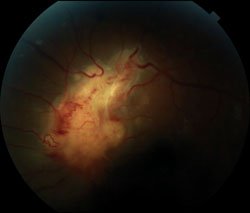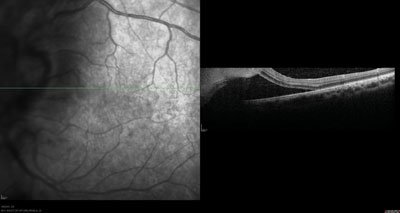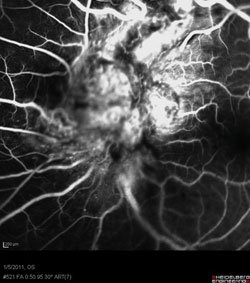Woman presents with decreasing vision, flashes and floaters
On examination, a large, yellow, vascularized lesion involving the optic nerve head was seen in the left eye.
 Priti Batta |
 Namrata Nandakumar |
by Steven L. Williams, MD, and Elias Reichel, MD
A 23-year-old Hispanic woman was referred to our eye clinic for progressively decreasing vision. She also reported having flashes and floaters in her left eye for 2 months. Her vision had been stable until 2 weeks before presentation, when she noticed a darkened, circular area in the center of her visual field. She denied any pain, photophobia or redness.
Her ocular history was significant for myopia and mild astigmatism. She had no significant medical history and was not taking any medications. She reported an allergy to penicillin and a family history of glaucoma.
Examination
The patient’s best corrected visual acuity was 20/20 in the right eye and 20/100 in the left eye. Her pupils were reactive, and her IOPs by Goldmann applanation tonometry were 13 mm Hg in the right eye and 14 mm Hg in the left eye. She had normal extraocular motility, and her visual fields were full to confrontation.
 Figure 1. Fundus photograph of the left eye, notable for a granulomatous mass involving the optic nerve head, with tortuosity of adjacent retinal vessels. Images: Williams SL, Reichel E
|
Anterior segment examination of both eyes was unremarkable. Posterior segment examination of the right eye was also normal. However, in the left eye, there was a large, yellow, vascularized lesion involving the optic nerve head (Figure 1). The lesion had poorly defined borders and was granulomatous in appearance. There was tortuosity of adjacent retinal vasculature, as well as lipid exudate and subretinal fluid extending toward the fovea. A mild vitritis was also present. Fluorescein angiography revealed leakage from the retinal vessels associated with the lesion (Figures 2a and 2b). Optical coherence tomography demonstrated subretinal fluid extending toward the fovea (Figure 3).
|
|
|
|
Figures 2a and 2b. Fluorescein angiography
images taken at 50 seconds (a) and 4:22 minutes (b), demonstrating a
vascularized lesion with late leakage. |
|
 Figure 3. OCT image demonstrates significant subretinal fluid extending into macula. |

What is your diagnosis?
Lesion involving optic nerve head
The differential diagnosis of an optic nerve head granuloma includes infectious causes such as syphilis and tuberculosis, as well as inflammatory conditions such as sarcoidosis. Less likely, leukemia can also lead to a focal leukemic infiltrate (leukoma) of the optic nerve head, which may have a similar clinical appearance.
This patient underwent a workup for these conditions. A syphilis screen was negative, as was a purified protein derivative. Her complete blood count was normal. However, a chest X-ray suggested bilateral hilar adenopathy. Her angiotensin converting enzyme (ACE) level was within normal range, although her lysozyme was elevated. Based on these tests, she was strongly suspected to have sarcoidosis.
Discussion
Sarcoidosis is a multisystemic disorder characterized by the accumulation of non-caseating granulomas in virtually any organ system. The presentation and course of the disease show considerable variability between individuals, ranging from self-limited disease to chronic, progressive disease resulting in severe impairment and even death. It is three times more common in blacks than in whites, and although there appears to be regional and ethnic differences, no clear pathogenesis has been discovered. Patient symptomatology is dictated by the affected organ system, ranging from decreased vision, photophobia and pain, in the case of ocular disease, to cough, dyspnea and chest pain, in the case of pulmonary involvement. Patients may also have constitutional symptoms, such as weight loss, fever, night sweats and malaise.
Ocular involvement is relatively common and may be the first clinical presentation of the disease. Typical ocular manifestations of the disease include nodular infiltration of the angle and iris, granulomatous iridocyclitis with “mutton fat” keratic precipitates, chorioretinal granulomas, and retinal vasculitis, commonly presenting with “candle wax drippings.” Ocular involvement can be unilateral or bilateral, with 30% of cases demonstrating posterior segment disease. Systemic disease typically shows lung/thoracic involvement, with bilateral hilar adenopathy being the most common finding. Cutaneous findings are also common, while cardiac, neurological and hepatic involvement are seen in a minority of patients.
Diagnosis and management
Ocular sarcoidosis should be strongly suspected among patients with nodular or granulomatous ocular lesions with concomitant uveitis. Diagnosis is often based on the clinical picture and supportive laboratory and radiographic findings, although confirmatory tissue biopsy is often done. Bilateral hilar adenopathy can be detected with a chest X-ray or thoracic CT scan and is the most sensitive diagnostic finding. Serum ACE is usually elevated in these patients and can correlate to the degree of pulmonary disease activity. However, ACE levels are neither highly sensitive nor specific, as levels can be elevated in other conditions, such as histoplasmosis and tuberculosis, and may be normal in patients with confirmed sarcoid. Other tests suggestive of the diagnosis include elevated serum/urine calcium levels, liver function tests and serum lysozyme. If there is diagnostic uncertainty, additional clinical work-up should include purified protein derivative, rapid plasma reagin and FTA-ABS to rule out the common infectious causes, such as tuberculosis and syphilis, of similar lesions. Treatment is dependent on the degree and location of ocular involvement, but usually involves some combination of topical, periocular and systemic steroids. Steroid-sparing immunosuppressants can be considered for chronic, progressive disease. Prognosis is typically good, although chronic systemic disease is associated with poorer outcomes. Chronic ocular manifestations include uveitis, cystoid macular edema and secondary glaucoma.
This patient was started on oral prednisone. She has shown improvement in her vision, with shrinkage of the granuloma and resolution of the vitritis. She is also being followed by a pulmonary specialist.
References:
- Iwata K, Nanba K, Sobue K, Abe H. Ocular sarcoidosis: evaluation of intraocular findings. Ann N Y Acad Sci. 1976;278:445-454.
- Jabs DA, Johns CJ. Ocular involvement in chronic sarcoidosis. Am J Ophthalmol. 1986;102(3):297-301.
- Poe RH, Utell MJ. Diagnosis and management of pulmonary sarcoidosis. Compr Ther. 1989;15(12):35-42.
- Winterbauer RH, Belic N, Moores KD. Clinical interpretation of bilateral hilar adenopathy. Ann Intern Med. 1973;78(1):65-71.
- Yanoff M, Duker JS. Ophthalmology. 3rd ed. Philadelphia: Elsevier; 2009.
- Steven L. Williams, MD, and Elias Reichel, MD, can be reached at New England Eye Center, Tufts University School of Medicine, 750 Washington St., Box 450, Boston, MA 02111; 617-636-4219; fax: 617-636-4866; website: www.neec.com.
- Edited by Priti Batta, MD, and Namrata Nandakumar, MD. Drs. Batta and Nandakumar can be reached at New England Eye Center, Tufts University School of Medicine, 750 Washington St., Box 450, Boston, MA 02111; 617-636-4219; fax: 617-636-4866; website: www.neec.com.



